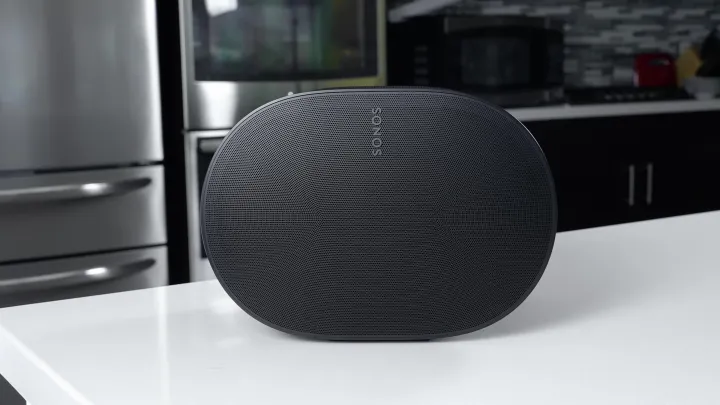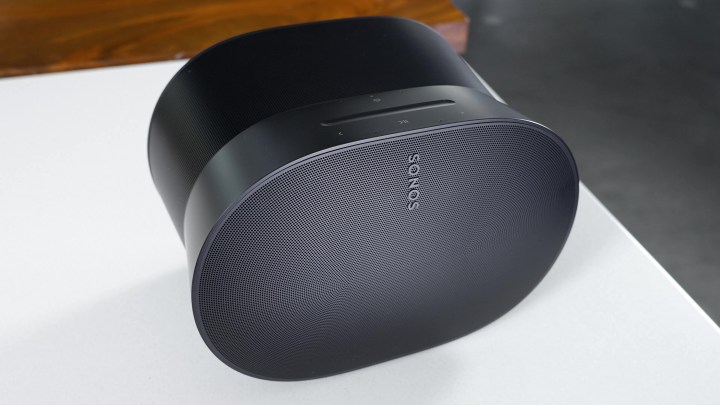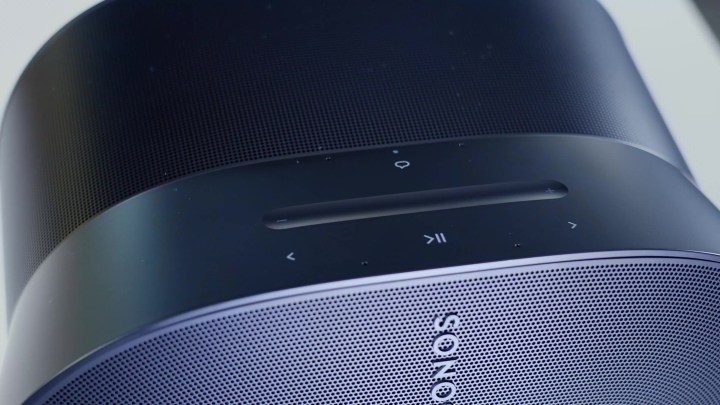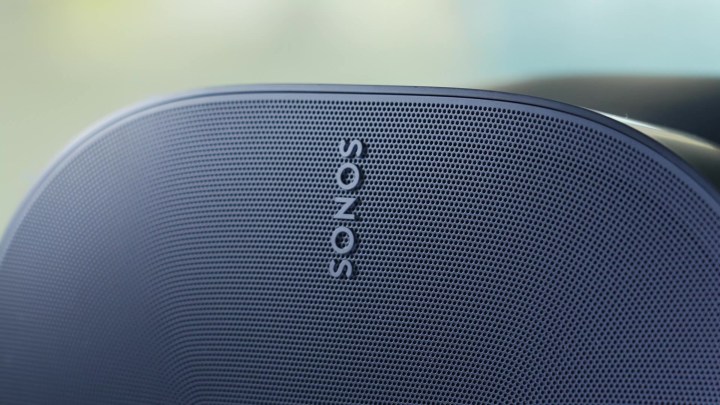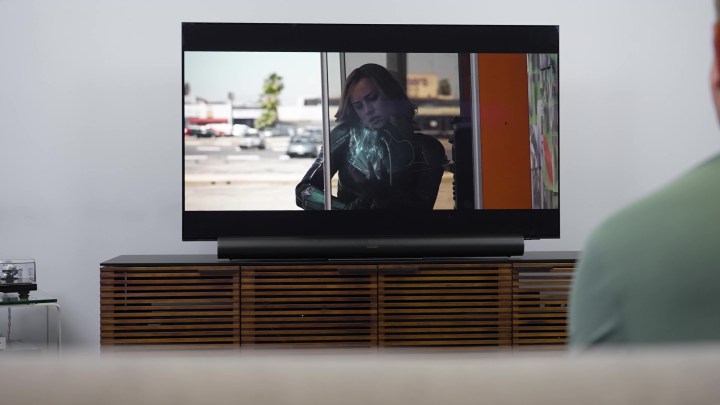This review has not at all gone according to plan. And I am not mad about it.
I’m a little late to the party, because, well, I kind of am! The new Sonos Era 300 speakers came out a couple of months ago, and along with them a rush of reviews — mostly wildly positive — absolutely singing their praises. This includes our own Simon Cohen, whose opinion I trust. There are a lot of “game-changer” headlines out there, which I typically to dismiss as hyperbole. So I wanted to try the Era 300 for myself.
Plus, I wanted to do something a little different: use the Era 300 as spatial audio (e.g., Dolby Atmos) surround speakers in conjunction with a Sonos Arc Dolby Atmos soundbar and a Sonos Sub to see what the ultimate Sonos home theater would sound like.
But I was so taken aback by the Era 300 speakers themselves that first I want to spend a little time talking about them and the various configurations I put them in because, for all the fanfare these speakers have received, I don’t think it’s enough. I have some observations I haven’t seen elsewhere, and a few suggestions as to what the right Sonos setup might look like for you, whether you want a high-performance smart speaker, multiroom audio, a clean speaker system for your TV, or a full-on Dolby Atmos home theater rig.
Sweet setup simplicity

It has been a while since I set up a Sonos speaker, and I’m super-pleased that getting them up and running is just as easy as I remember. Sonos’ app — its user interface — is a big part of why Sonos is so well-loved. I plugged in one of the Era 300 speakers, the app found it, connected it to my Wi-Fi without asking for the password because it’s already stored in my phone, and then prompted me to run TruePlay, which is Sonos’ absolutely stellar sound optimization feature. You walk around the room waving your phone around and TruePlay reads the room through your phone’s microphone and optimizes the speaker’s output. It works extremely well, and the Era 300 and Era 100 solve a long-standing problem of needing an iPhone for TruePlay. The sound profile with TruePlay for me is significantly better than without it. You can toggle it on and off to hear for yourself after you run it in your own room.
Sonos spatial audio
I started with just one Era 300 because I think a lot of folks are likely to have just one of these in a given room. You may have already seen its sort of hourglass shape — one that folks were quick to hate when they first saw images of it ahead of its official launch. But the design — which I think looks just fine — is actually a classic example of function leading form. The speaker is shaped this way to accommodate a series of drivers that shoot sound out of the sides and the top of the speaker, as well as straight out the front. And that’s all in service of producing Spatial Audio and, by extension, Dolby Atmos audio, both of which we are going to spend a significant amount of time talking about here. While you might expect the Era 300 to sound good because it’s a Sonos speaker — and Sonos speakers are known to sound very, very good — you might not expect the spatial audio aspect to work as well as it does.
I was astonished at how well just one speaker can pull off the atmospheric effect of spatial audio.
Now, to get spatial audio, you have to listen to music or movies that have been mixed for it. You can get spatial audio music from Apple and Amazon’s music services (we’ll get to TV and movies in a moment), and you need to make sure that the track or album you are listening to is available with spatial audio. Not all music has been optimized yet. But if you want to experience it, you can use the search function in the Sonos App to find music in spatial audio. Apple makes it very easy to find. You can also disable spatial audio in your Apple device if you decide you don’t like how spatial audio sounds.
I’m going to take a quick sidebar here and say that the spatial audio version of music is not always the better version. Just because it has been mixed for spatial audio doesn’t mean it necessarily sounds better that way. This is not a comment on the Sonos speakers — or any spatial audio system for that matter. This is a comment on the spatial audio mixing itself. What I’ve found is that sometimes it is awesome, and sometimes it actually takes something away.
Going back to the single Era 300 speaker, it sounded outstanding with both spatial and non-spatial audio tracks. The bass output of this speaker is remarkably good for the speaker’s size. It is the least forced — or fake-sounding — bass I’ve heard from a relatively compact speaker before. And that’s saying something. Compared to the HomePod, which admittedly is both smaller and less expensive, the Era 300 is a substantially superior-sounding speaker.
And when the spatial audio mix is good, the spatial audio performance of even just one Era 300 is outstanding — even kind of unbelievable.
Double the fun
But you know what’s even better than the Era 300? Two Era 300s, linked in stereo. (That’s true with most Sonos speakers, actually, but stay with me here.)
You plug in another Era 300, the Sonos app finds it, you add it to the same room, and the app will ask you to identify the left and right speakers. And, boom, you have a stereo pair.
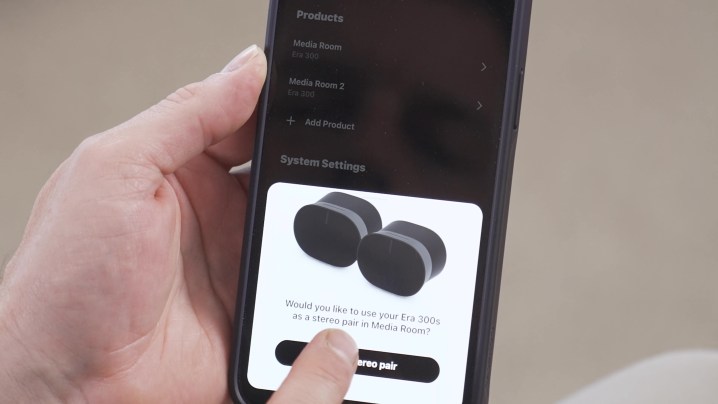
This is when my opinion of the Era 300 skyrocketed. If one Era 300 sounds very, very good, then two of them in stereo are just superb. And I don’t just mean for a powered smart speaker – I would put a stereo pair of Era 300 against any number of high-performance bookshelf speaker and amplifier combinations that cost way, way more money. I’d put them against Klipsch’s The Fives, The Sevens, and, yeah, The Nines, too. The sound is so remarkably good.
Everything is better with the pair. The bass is outstanding. It’s tight, and the resonance is just right. The intonation of the bass was spot-on! I listened to Oscar Peterson’s We Get Requests, which features Ray Brown on upright acoustic bass, and his unmistakable, iconic tone was reproduced so faithfully that I had to dig deep into my memory to think of a time when it sounded better. And if it has sounded better, it came from a system that costs at least four times as much as a pair of these speakers.
The dome of sound you might be looking for? It’s right here.
The imaging in stereo mode — again, not spatial audio mode — was stellar, with pinpoint center imaging, as well as a soundstage that spread well beyond the outside edges of the speakers and was seamless across the front of the room. No holes anywhere. Transients were super-clean, dynamics were quick and arresting. And then kick in spatial audio? I mean, forget about it. The spatial audio was exponentially better with a pair of these speakers.
I felt no need for a subwoofer. But I did get a Sonos Sub, so I added one in. And while it is true that the sub adds authority to the lowest octave, I honestly feel the system sounds better without it. That’s not because the Sonos Sub is incapable of good bass, but because the Era 300 provided more even bass since there were two of them running full range when they are on their own, but they get crossed over and lean on the subwoofer quite a bit when it’s added.
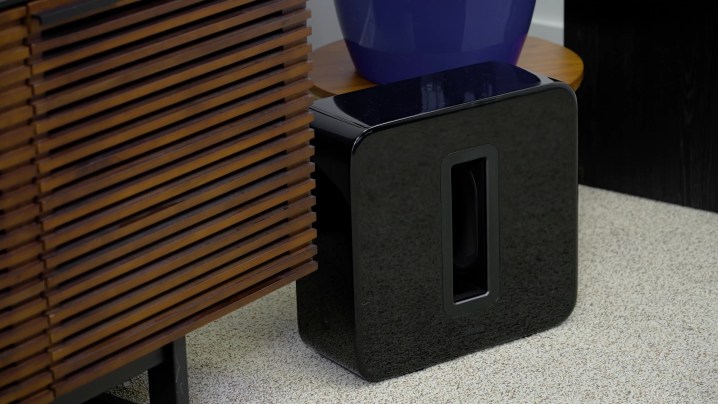
All this to say that if music is your priority, you can probably skip the sub, even in a sizable room. Two Era 300s sound awesome. And if you really want the big bass? Just go for it and get two Sonos subwoofers. Two will definitely be better than one. But that adds a significant cost.
TV speakers
Now, before I move on to the full surround system with the Sonos Arc soundbar and the sub, I want to talk about the idea of using two Era 300 as TV speakers. This is something I did with the Apple HomePods when the second generation came out, and I was super-impressed with that pairing. So, can the Era 300 do it too?
Technically, yes. Sonos hasn’t designed the Era 300 for this purpose — it’d prefer you get one of its soundbars for TV use — and as such, there’s no way to pump uncompressed sound out to these speakers via HDMI without a Sonos Arc or Sonos Beam because the Era 300 don’t have an HDMI input on them. So they fall short of being a direct replacement candidate for something like Klipsch’s The Fives, Sevens, or Nines in that way.
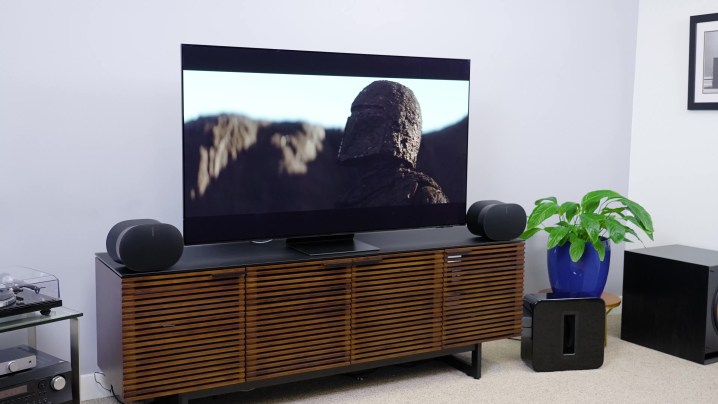
They do, however, support AirPlay 2. So, if you are using an iPhone, iPad, Mac, Apple TV 4K box, or a TV that supports AirPlay 2 output, then you can use the Era 300 as TV speakers.
And they sounded good at that job. But for some reason — even though they offered a lot of sound and very good Dolby Atmos effects — they didn’t have the pinpoint center imaging for dialogue that I got out of the HomePods. The dialogue was clear, but it didn’t seem to come from the center of the TV screen due to the “phantom center” effect good stereo speakers can create.
I’m not sure why that is. It might be that the HomePods get a special signal because they are Apple Hardware. I’ve actually asked and have not gotten a response yet, so I’ll update this when I do hear back.
Ultimate Sonos home theater
But really, if you want a home entertainment system and you want a full-on Dolby Atmos 7.1.4 system, then what you should do is get a Sonos Arc, a Sonos sub, and use two Era 300 as surround speakers. I did that, and holy Toledo, folks, this system beats out almost every soundbar surround system I’ve ever tested – the Nakamichi Dragon being the one exception.
- 1. Sonos Arc
You’ll pay for it. We’re talking about a $2,400 system here — that’s the street price, not MSRP. That’s well more than you’d pay for Samsung’s outstanding, top-of-the-line Dolby Atmos soundbar system. But the performance is significantly more convincing when it comes to the Dolby Atmos effects, and the overall fidelity of the sound is better, too — even though the Samsung system does sound remarkably good for what it is.
The real feather in your cap with a Sonos system like this, though, is the flexibility it offers. See, the Era 300 can live in other rooms of your house, providing multiroom audio, and then you can place them in your TV room and use them as surrounds when you want to. The Era 300 can even take analog audio sources like a turntable and pump that sound throughout your home, if you’d like. That kind of versatility isn’t something you can expect from most soundbar-based surround systems.
Unbeatable value
Sonos is a luxury good and it’s going to cost you a chunk of change. But a pair of Era 300s is honestly one of the best deals in home audio. You can’t get spatial audio sound like this from anything for less than $900, which is what you’ll pay for a pair. I’ve checked — the least expensive Klipsch bookshelf speakers, paired with Atmos modules and the least expensive Atmos A/V receiver, is going to run you at least $900 and aren’t likely to sound this good. And don’t forget the speaker cables.
A pair of HomePods gets close, but if you’re willing to spend a little more, you’ll be treated to world-class sound paired with one of the best user experiences there is in home entertainment.
Editors' Recommendations
- Sonos Atmos vs. Nakamichi Dragon: beauty and the beast
- Bluetooth on Sonos’ new Era speakers isn’t what you think – it’s better
- Sonos teases upcoming launch of the Era generation

